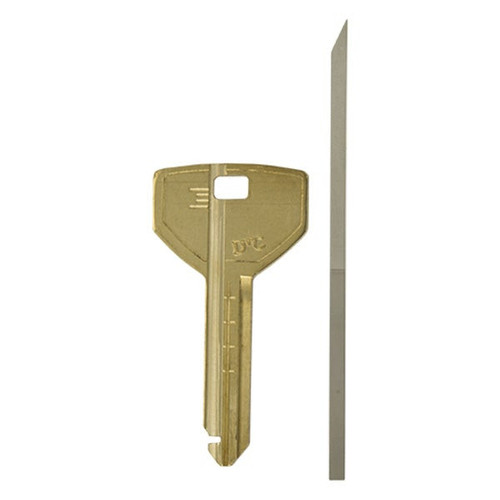This EEZ Reader is designed to decode all North American Chrysler locks starting with the single-sided system found in the 1989 Spirit and Acclaim models. In 1990, then Briggs & Stratton, now Strattec, introduced the double-sided system into the Chrysler line.The EEZ Y154 will read all locks except the 1993 trunk lock. In this case, there is a ward in the lock profile that the tool will not pass. However, you do not need to read the trunk in 1993. You can decode the entire system by using alternative locks such as ignition and door.
Cross-reference: Y154, Y155
Codes: F00000 - F13940
Code Card: X59
Applications: Spirit & Acclaim 1989; All Chryslers 1990-1995 (Except 1993 Trunk Lock)
Click Here to Download EEZ-CHY-Y154 Instructions
About EEZ Readers:
EEZ Readers tools work very well and read very accurately even on used and worn locks.
EEZ Readers are designed to decode the tumbler depths in single- and double-throw wafer locks. Each lock mechanism requires a specific model reader. Decoding the depths of cut using these tools require using feel, not sight reading, which is a learned technique.
EEZ Reader is designed in two parts. One is the "Key Tool" made from the proper key blank. The other is the "Slide Tool" made from flat spring steel.
The tool is milled to fit with the slide tool. The tip end has a slot to trap each wafer individually. On the side of the blade are marks which index at the face of the lock to note which wafer is trapped. On the head are marks calibrated to the slide tool, one for each wafer depth cut.
The slot at the tip end is wider than the wafer. The calibration is from the head side of the slot. Therefore, you need inward pressure on the key tool to hold the wafer snug to that side of the slot. If you pull out on the key tool, you will get a higher reading. Also, inward pressure will help hold the wafer in place for a touch stop while using the slide tool.
The slide tool is cut with a slope on one end and has an index mark on the side. The slope is used to raise the wafer up out of the slot of the key tool, to adjust to another wafer and to inset and remove tool from the lock. The slope is also used to gauge the depth of the wafer that is trapped. With the wafer trapped in the slot of the key tool and inward pressure applied, the slide tool is slid in with very light pressure until the slope touches the wafer. In this position, the index mark on the slide tool will align with one of the depth marks on the key tool. That is the depth reading of the trapped wafer.
To use, put the tool together with the tip and slope even. Insert to the last wafer at the rear of the lock. Ease the slide tool outward to allow the wafer at the rear of the lock. Ease the slide tool outward to allow the wafer to settle in the slot of the key tool. You may want to move the key tool around a bit to ensure that wafer is in the slot completely. Apply and hold moderate inward pressure on the key tool. Hold the slide tool with your fingertips lightly and slide the slide tool in until it just touches the wafer. You feel a distinct stop but if you press too hard, you raise the wafer, so EEZ does it.
Read and record the depth mark on the head of the key tool that aligns with the index mark on the slide tool.
Release the inward pressure on the key tool. Slide the slide tool in and raise the wafer out of the slot in the key tool. Adjust outward one mark on the side of the key tool at the face of the lock. Then proceed as before.
Putting the tool together to insert to the read wafer should remove the danger of getting the key tool trapped alone in an incorrect lock and not be able to insert the slide tool to remove the key tool. If it will go in with both pieces together, it should come out.
On used and worn locks, the front of the plug and first wafers are worn more than the rear ones. By going to the rear and reading outward, you should readily see to adjust your readings.
The rear wafer usually reads accurately. As you progress outward, you will see the readings progressively higher for the correct cut depth. On an extremely worn lock, don't be surprised if you get a reading of one increment higher for the first wafer.
When in doubt, cut higher. The key will probably turn, but like a tight nut. Take the key out, inspect it and you will an impression mark. (You know what do now.)
It is important to hold the key tool in a straight line with the keyway on the outer wafer.
-
Product Type
Picks & Decoders
-
Item #:
28579
-
SKU:
EEZ-CHY-Y154





